Electronic Monitoring Statistics Publication, England and Wales: March 2024
Published 25 April 2024
Main points
This publication sets out statistics on the use of electronic monitoring from 31 March 2023 to 31 March 2024.
| The number of individuals fitted with an electronic monitoring device increased by 16% | The total number of individuals fitted with an electronic monitoring device (a radio frequency, location monitoring device or alcohol monitoring device) as at 31 March 2024 was 20,084, an increase of 16% from 17,350 as at 31 March 2023. |
| Court bail orders remains the largest cohort of individuals fitted with an electronic monitoring device | The number of individuals fitted with an electronic monitoring device under a court bail order as at 31 March 2024 was 7,154, an increase of 14% from 6,284 as at 31 March 2023. Court bail accounted for 36% of all individuals fitted with an electronic monitoring device. |
| The number of individuals fitted with a radio frequency device (RF) accounts for 37% of individuals fitted with a device | The number of individuals fitted with a radio frequency device (RF) as at 31 March 2024 was 7,450, a decrease of 5% from 7,832 as at 31 March 2023. |
| The number of individuals fitted with a location monitoring device (GPS) accounts for 50% of individuals fitted with a device | The number of individuals fitted with a location monitoring device (GPS) as at 31 March 2024 was 10,031, an increase of 36% from 7,398 as at 31 March 2023. |
| The number of individuals fitted with an alcohol monitoring (AM) device increased by 27% | The number of individuals fitted with an alcohol monitoring (AM) device as at 31 March 2024 was 2,862, a 27% increase from 2,248 as at 31 March 2023. |
Statistician’s comment
Between 31 March 2023 and 31 March 2024, the number of individuals fitted with an electronic monitoring device increased. This has been driven by the increased use of GPS devices, particularly for the immigration and court bail cohorts, although there has been a continued decrease in the use of RF devices.
Court bail orders remain the largest cohort of individuals fitted with an electronic monitoring device, accounting for 36% (7,154) of the 31 March 2024 caseload. The use of electronic monitoring for those on court bail increased sharply in early 2020 in response to the covid pandemic’s impact on the courts, reaching a peak in March 2021. Although numbers declined a little before stabilising, from June 2022 the numbers again increased and are now at record levels.
In the year ending 31 March 2024 there were 59,154 new order notifications, a 10% increase compared to the year ending 31 March 2023. In the same period there were 55,759 completed orders, a 9% increase on the previous period.
This release is part of the Electronic Monitoring statistics publication series. Feedback on the content and format of the release is welcome: please see contact details section for further information.
Background
Electronic monitoring supports probation, prisons, courts, the police, the Home Office and the wider justice system in England and Wales. It is a way of remotely monitoring and recording information on an individual’s whereabouts or movements and alcohol consumption, using an electronic device (tag) which is normally fitted to an individual’s ankle. Information about the compliance with an individual’s order is monitored. Electronic monitoring may be used:
-
as a condition of court bail;
-
as a requirement of a court sentence, primarily community orders and suspended sentence orders;
-
for Home Detention Curfew;
-
as a licence condition following release from custody;
-
as a condition of immigration bail, managed by the Home Office; or
-
to intensively monitor a small number of individuals including: some of the highest risk offenders managed under Multi-Agency Public Protection Arrangements (MAPPA); those granted bail by the Special Immigration Appeals Commission (SIAC); and those made subject to Terrorism Prevention and Investigation Measures (TPIMs).
Electronic monitoring was first introduced in 1999 to monitor compliance with curfews using radio frequency devices, where curfew is the only requirement, these continue to be used. The service was expanded from November 2018 to introduce satellite enabled location monitoring devices. The devices use GPS technology which can record an individual’s movements 24 hours a day. Roll out was fully completed in March 2021 when the provision of GPS monitoring was extended to under 18s.
GPS devices provide additional functionality, allowing the monitoring of:
-
compliance with exclusion zones;
-
attendance at a required activity or appointment;
-
an offender’s whereabouts, known as trail monitoring. This can provide Probation Practitioners with data about an individual’s whereabouts to support rehabilitative conversations. The Police Courts and Sentencing Act 2022 introduced this for Youth Rehabilitation Orders (this is not available for court bail).
-
multiple conditions or requirements if necessary, such as a combination of exclusion zones, curfew, monitored attendance and trail monitoring.
Since 2021 HMPPS has expanded the use of GPS devices for the following offender cohorts:
-
acquisitive crime: From April 2021, they have been used as a licence condition for some adult offenders convicted of a specified acquisitive crime as their principal offence and who have received a custodial sentence of 12 months or more and been released on licence. In late October 2022 this was expanded to those who had received a custodial sentence of 90 days or more. This is currently being piloted in 19 police force areas.
-
several small pilots for specific offender cohorts, such as Licence Variation, GPS Youth Rehabilitation, and Domestic Abuse Perpetrators on Licence.
-
immigration expansion: The Immigration Act 2016 introduced a duty on the Home Office Secretary of State to impose an electronic monitoring condition on Foreign National Offenders (FNOs) and other non-UK citizens subject to deportation proceedings. Following this, in August 2021, HMPPS began using GPS monitoring for those individuals who had been released from Prisons or Immigration Detention under ‘Immigration Bail’ on behalf of the Home Office. From 31 August 2022, this was extended to Scotland and Northern Ireland in December 2022. The Home Office also commenced a pilot in June 2022 to impose an electronic monitoring condition of immigration bail to non-FNO asylum claimants who arrive in the UK via unnecessary and dangerous routes. This pilot concluded in December 2023.
Electronic monitoring using a non-fitted device was introduced in November 2022 for the immigration cohort. These devices utilise periodic biometric verification as an alternative to using fitted devices. Those with a non-fitted device have been included within the GPS cohort for the purposes of this analysis.
Alcohol monitoring was introduced to courts in Wales in October 2020 and expanded to courts in England on 31 March 2021 to support the new community sentencing option, the Alcohol Abstinence and Monitoring Requirement (AAMR). An AAMR may only be used when sentencing for alcohol-related criminal behaviour and it imposes a total ban on drinking alcohol for up to 120 days. Compliance with the ban is monitored electronically using an alcohol monitoring device which continuously monitors for the consumption of alcohol via an offenders’ sweat.
An AAMR order may be imposed by the court as part of a community order or suspended sentence order where:
-
the offence, or associated offence, for which the requirement is being imposed, is alcohol-related;
-
the individual is not alcohol dependent or has an Alcohol Treatment Requirement (ATR) recommended or in place; and
-
the individual is an adult (18 years or over).
For offenders being released from custody whose offending and risk is alcohol related, an Alcohol Monitoring on Licence (AML) additional licence condition was introduced in Wales in November 2021 and rolled out in England in June 2022. There are two licence conditions available for AML:
-
requires total abstinence from alcohol, or
-
requires the offender to comply with requirements specified by their Probation Practitioner to address their alcohol needs, this will include restricting alcohol use.
1. Overall summary
An individual may be given several orders at the same time and/or over the course of a year, therefore there will be more active orders at any one time than there are people being monitored. If an individual has multiple orders, when looking at order notifications, each will be counted separately. However, when counting individuals, the individual will be included in an order cohort once according to a defined formula. Please see the technical note for more details.
Between 31 March 2023 and 31 March 2024, the total number of individuals fitted with an electronic monitoring device (a radio frequency, location monitoring device or alcohol monitoring device) increased from 17,350 people to 20,084, an increase of 16%.
Figure 1: Overall number of individuals fitted with an Electronic Monitoring device, England and Wales, as at month-end, from March 2017 to March 2024 (Source: Table 1.1)
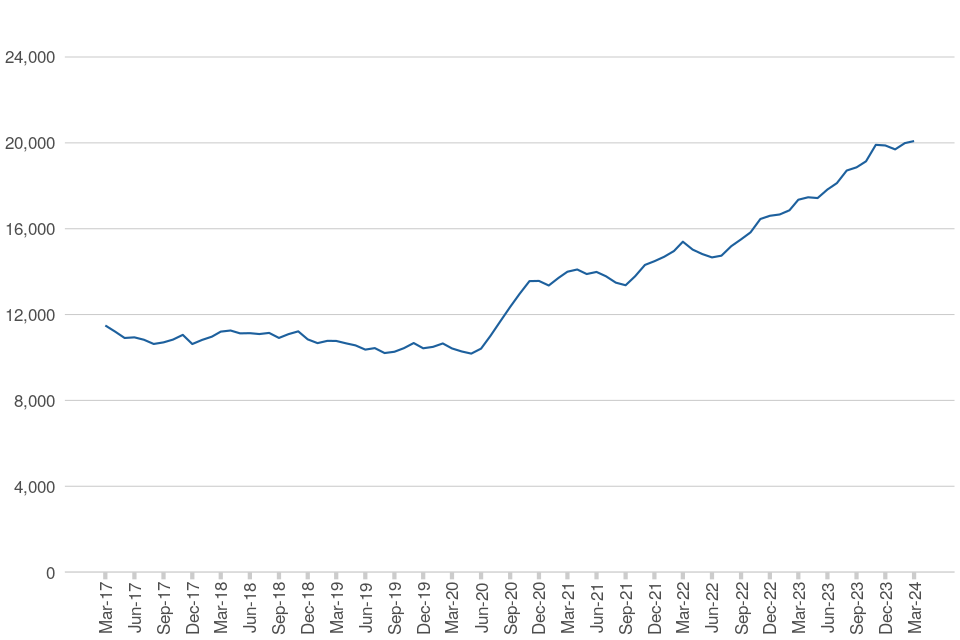
However, the trend in the overall number of individuals fitted with an electronic device differs considerably by type of order:
-
court bail orders make up the largest proportion (36%) of electronically monitored individuals. At 31 March 2024, 7,154 individuals had court bail as their primary order type, up by 14% on the previous year. The use of electronic monitoring for those on court bail increased sharply in early 2020. Although numbers declined during 2021, from mid-2022 the numbers have again been increasing.
-
post-release orders were the second largest group with 5,440 individuals (27% of the caseload), up by 33% when compared with the previous year. This increase is mainly due to the increased use of alcohol monitoring for this group.
-
immigration orders were the third largest group with 4,371 individuals (22% of the caseload), up by 24% when compared with the previous year. The number of individuals in this cohort has steadily increased from August 2021 owing to the expansion projects.
-
court sentences (community orders and suspended sentence orders) were the fourth largest group with 3,034 individuals (15% of the caseload), down by 10% on the same point in the previous year. The numbers recovered following a sharp decline in early 2020 as a result of pressure on courts from the covid pandemic, the numbers again declined in mid-2022. This decrease from April 2022 is likely to be associated with mandating domestic abuse and safeguarding enquiries, in all cases where electronic monitored curfews are proposed, which was introduced at this time. From April 2022, those with a primary order type of community sentence with an RF device has decreased.
Figure 2: Individuals fitted with an Electronic Monitoring device, by order type (excluding Specials), England and Wales, as at month-end, from March 2017 to March 2024 (Source: Table 1.1)
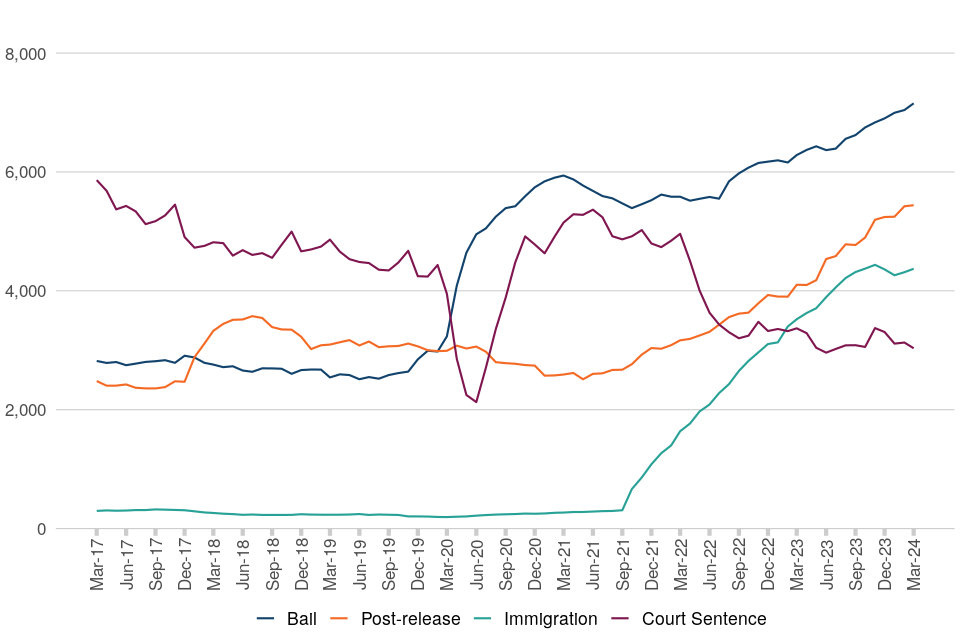
2. Radio Frequency Monitoring
Between 31 March 2023 and 31 March 2024, the total number of individuals fitted with an electronic monitoring device and whose primary order was a RF order decreased from 7,832 individuals to 7,450, a decrease of 5%. Over the same period the proportion of individuals whose primary order was a RF order decreased from 45% to 37%.
-
court bail RF orders make up the largest proportion (56%) of RF monitored individuals. At 31 March 2024, 4,140 individuals had RF court bail as their primary order type, a decrease of 4% on the previous year. The use of electronic monitoring for those on RF court bail increased sharply in early 2020 in response to the covid pandemic’s impact on the courts.
-
post-release RF orders were the second largest group with 2,038 individuals (27% of the RF caseload), up by 15% when compared with the previous year.
-
court sentence RF orders (community orders and suspended sentence orders) were the third largest group with 1,272 individuals (17% of the caseload), down by 28% when compared with the previous year. The decline from April 2022 is likely to be associated with mandating domestic abuse and safeguarding enquiries in all cases where electronic monitored curfews are proposed is continuing.
-
as at 31 March 2024, there are no individuals that had immigration RF orders as their primary order type. HOIE have primarily used GPS devices since 2021 which has significantly reduced the numbers of RF devices used.
Figure 3: Individuals fitted with a Radio Frequency Monitoring device, by order type (excluding Specials), England and Wales, as at month-end, from March 2017 to March 2024 (Source: Table 2.1)
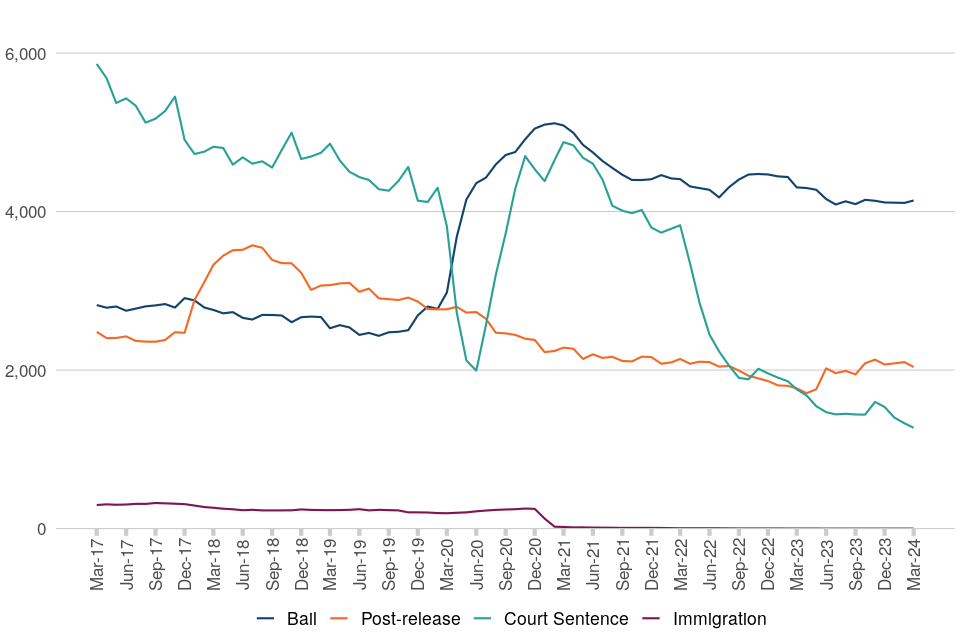
3. Location (GPS) Monitoring
Between 31 March 2023 and 31 March 2024, the number of individuals fitted with an electronic monitoring device and whose primary order was a GPS order increased from 7,398 individuals to 10,031, an increase of 36%. Over the same period the proportion of individuals whose primary order was a GPS order increased from 43% to 50%. As at 31 March 2024, GPS immigration bail accounted for 44% of all individuals whose primary order was a GPS order.
There were 2,140 new acquisitive crime orders imposed across England and Wales in the year ending 31 March 2024. Overall, 5,253 new acquisitive crime orders have been imposed since they were introduced.
Figure 4: Individuals fitted with a Location Monitoring device, by order type (excluding Specials), England and Wales, as at month-end, December 2018 to March 2024 (Source: Table 3.1)
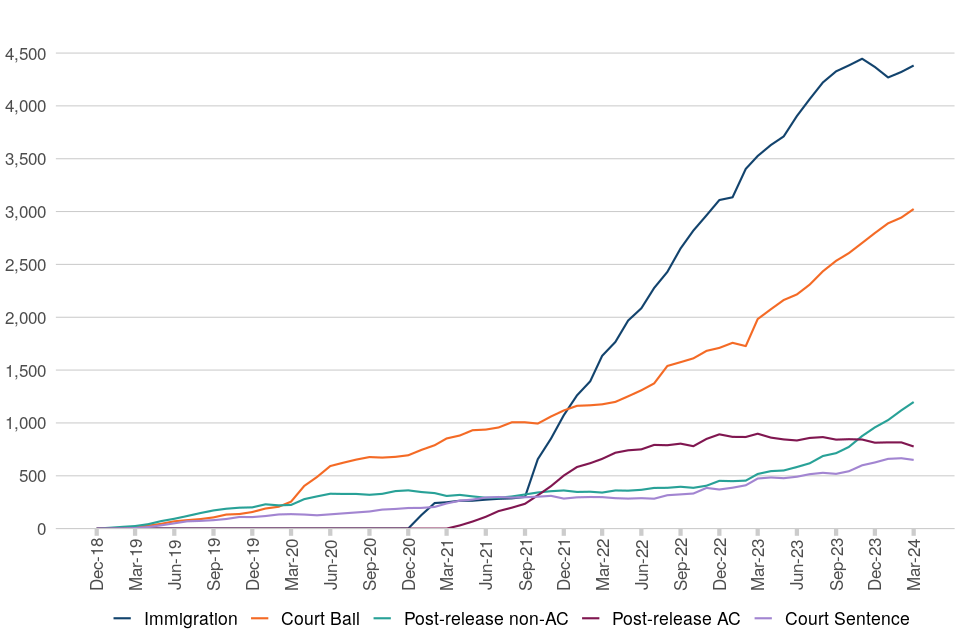
4. Alcohol Monitoring
Between 31 March 2023 and 31 March 2024, the total number of individuals fitted with an alcohol monitoring device increased from 2,248 individuals to 2,862, an increase of 27%.
There were 12,506 new alcohol monitoring orders imposed across England and Wales in the year ending 31 March 2024. Overall, 24,305 new alcohol monitoring orders have been imposed since their introduction.
Of the alcohol monitoring devices in use to monitor AAMRs over the last quarter, between December 2023 and March 2024, the devices did not register a tamper or alcohol alert for 97.7% of the days worn. Since their introduction in October 2020, the devices did not register a tamper or alcohol alert for 97.3% of the days worn.
Figure 5: Overall number of individuals with an Alcohol Monitoring order, England and Wales, as at month-end, October 2020 to March 2024 (Source: Table 4.1)
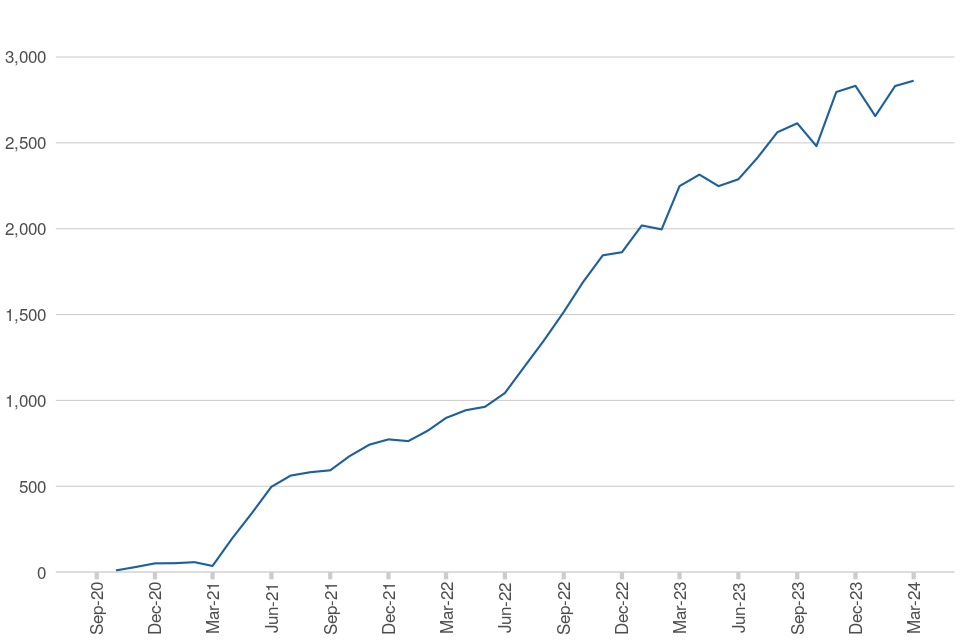
Further information
Accompanying files
As well as this bulletin, the following products are published as part of this release:
-
Data tables
-
Technical note
Official Statistics
Our statistical practice is regulated by the Office for Statistics Regulation (OSR). OSR sets the standards of trustworthiness, quality and value in the Code of Practice for Statistics that all producers of official statistics should adhere to. You are welcome to contact us directly with any comments about how we meet these standards. Alternatively, you can contact OSR by emailing regulation@statistics.gov.uk or via the OSR website.
The statistics in this bulletin are classified as official statistics. The Statistics and Registration Service Act 2007 defines ‘official statistics’ as all those statistical outputs produced by the UK Statistics Authority’s executive office (the Office for National Statistics), by central Government departments and agencies, by the devolved administrations in Northern Ireland, Scotland and Wales, and by other Crown bodies (over 200 bodies in total).
This publication has been produced to the high professional standards as set out in the Code of Practice for Statistics. However, the analysis is only as good as the data upon which it is based, and there is inherent uncertainty when the data is derived from diverse administrative data systems.
For further details on the methodology used to compile the report, please refer to the technical note.
Future publications
Our statisticians regularly review the content of publications. Development of new and improved statistical outputs is usually dependent on reallocating existing resources. As part of our continual review and prioritisation, we welcome user feedback on existing outputs including content, breadth, frequency and methodology. Please send any comments you have on this publication including suggestions for further developments or reductions in content.
New contracts to deliver the Electronic Monitoring service from May 2024 have been awarded. More details can be found here. To ensure the publication series continues to meet our high accuracy and quality standards we may need to temporarily pause the series towards the end of 2024, to allow us to adapt our coding and processes. If there is a pause to the publication series, the full data set will be available when the series restarts. If this will cause difficulties, please do let us know.
Contact
Press enquiries should be directed to the Ministry of Justice press office.
Other enquiries about these statistics should be directed to Data and Analysis at the Ministry of Justice:
HMPPS Electronic Monitoring Performance
Data and Analysis
Ministry of Justice
10th Floor
102 Petty France
London
SW1H 9AJ
Email: ppas_statistics@justice.gov.uk
Next update: July 2024
© Crown copyright
Produced by the Ministry of Justice
Alternative formats are available on request from ppas_statistics@justice.gov.uk
